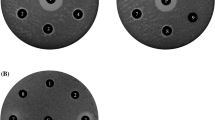Abstract
Probiotics are beneficial bacteria that exert beneficial health effects on the host. These bacteria produce lactic acid as a product of fermentation. The aim of this study was to optimize growth and production of lactic acid by three strains of probiotic bacteria at different concentrations of sucrose, glucose, stevia leaf and stevioside. These three strains were Lactobacillus casei, Lactobacillus brevis and Lactobacillus plantarum. Lactic acid production and bacterial growth were, respectively, estimated by use of gas chromatography and colony-forming units (CFU) assay. The highest bacterial growth and lactic acid production in these three strains were obtained by high concentration of sucrose. Among these three bacteria, Lact. casei and Lact. brevis can produce more lactic acid compared to Lact. plantarum. All strains could produce lactic acid in the presence of sucrose, glucose and stevia leaf extract in a dose dependent manner. The effect of stevioside on lactic acid production in these strains at high and low concentrations was almost same. In conclusion, data indicate that sucrose is the best carbon source for lactic acid production and bacterial growth. Stevioside and stevia leaf also have a good potential to increase lactic acid production in these three strains.




Similar content being viewed by others
References
Akın MB, Akın MS, Kırmacı Z (2007) Effects of inulin and sugar levels on the viability of yogurt and probiotic bacteria and the physical and sensory characteristics in probiotic ice-cream. Food Chem 104:93–99
Anton S, Martin C, Han H, Coulon S, Cefalu W, Geiselman P (2010) Effects of stevia, aspartame, and sucrose on food intake, satiety and postprandial glucose and insulin levels. Appetite 55:37–43
Benford DJ, Hill F, Schlatter J, Di-Novi M (2009) Steviol glycosides (addendum). In: Joint FAO/WHO expert committee on food additives (JECFA), safety evaluation of certain food additives. Sixty-ninth meeting: food additives, pp 183–219
Champagne CP, Gardner NJ, Roy D (2005) Challenges in the addition of probiotic cultures to foods. Food Sci Nutr 45:61–84
Chan P, Tomlinson B, Chen YJ, Liu JC, Hsieh MH, Cheng JT (2000) A double-blind placebo-controlled study of the effectiveness and tolerability of oral stevioside in human hypertension. Br J Clin Pharmacol 50:215–220
Coelho LF, de Lima Bolner CJ, Bernardo MP, Contiero J (2011) D(−) lactic acid production by Leuconostoc mesenteroides B512 using different carbon and nitrogen sources. Appl Biochem Biotechnol 164:1160–1171
Das K, Dang R, Shivananda T (2006) Effect of N, P. K fertilizers on their availability in soil in relation to the Stevia plant (Stevia rebaudiana Bert.). Arch Agron Soil Sci 52:679–685
Debnath M (2008) Clonal propagation and antimicrobial activity of an endemic medicinal plant Stevia rebaudiana. J Med Plant Res 2:45–51
Georgieva R, Koleva P, Nikolova PPD, Yankov PPD, Danova PPS (2009) Growth parameters of probiotic strain lactobacillus plantarum, isolated from traditional white cheese. Biotechnol Biotechnol Equip 23:861–865
Gonçalves LMD, Barreto MTO, Xavier AMBR, Carrondo MJT, Klein J (1992) Inert supports for lactic acid fermentation—a technological assessment. Appl Microbiol Biotechnol 38:305–311
Guarner F, Schaafsma GJ (1998) Probiotics. Int J Food Microbiol 39:237–238
Jeppesen P, Gregersen S, Alstrup K, Hermansen K (2002) Stevioside induces antihyperglycaemic, insulinotropic and glucagonostatic effects in vivo: studies in the diabetic goto-kakizaki (GK) rats. Phytomedicine 9:9–14
Kinghorn AD, Wu CD, Soejarto DD (2001) Stevioside. In: Alternative sweeteners (3rd edn, Revised and Expanded), O’Brien Nabors L (ed), Marcel Dekker, Inc., New York, pp 167–183
Klein G, Pack A, Bonaparte C, Reuter G (1998) Taxonomy and physiology of probiotic lactic acid bacteria. Int J Food Microbiol 41:103–125
Magdaleva PB, Adam W, Monika KW (2010) Optimization of medium composition for enhancing growth of Lactobacillus rhamnosus PEN using response surface methodology. Pol J Microbiol 59:113–118
Maki KC, Curry LL, Carakostas MC, Tarka SM, Reeves MS, Farmer MV, Bisognano JD (2008) The hemodynamic effects of rebaudioside A in healthy adults with normal and low-normal blood pressure. Food Chem Toxicol 46:S40–S46
Soejarto DD, Kinghorn AD, Farnsworth NR (1982) Potential sweetening agents of plant origin. Organoleptic evaluation of stevia leaf herbarium samples for sweetness. J Nat Prod 45(5):590–599
Parada JL, Sambucetti ME, Zuleta A, Rio ME (2003) Lactic acid fermented products as vehicles for probiotics. New horizons in biotechnology. Kluwer Academc Publishers, Boston, pp 335–351
Puri M, Sharma D (2011) Antibacterial activity of stevioside towards food borne pathogenic bacteria. Eng Life Sci 11:326–329
Rose CS, Luchi RJ, Avery A, Norris RF, György P (1952) Mono- and disaccharides in growth of Lactobacillus bifidus and Its mutants. Exp Biol Med 81:712–715
Srinivas D, Mital BM, Garg SK (1990) Utilization of sugars by Lactobacillus acidophilus strains. Int J Food Microbiol 10:51–57
Soejarto DD, Kinghorn AD, Farnsworth NR (1982) Potential sweetening agents of plant origin III
Tavarini S, Ribuoli M, Bimbatti M, Angelini LG (2010) Functional components from stevia rebaudiana bert leaves. Biotechnology 150:S326–S326
Vinderola CG, Costa GA, Regenhardt S, Reinheimer JA (2002) Influence of compounds associated with fermented dairy products on the growth of lactic acid starter and probiotic bacteria. Int Dairy J 12:579–589
Weber A, Hekmat S (2013) The effect of Stevia rebaudiana on the growth and survival of Lactobacillus rhamnosus GR-1 and sensory properties of probiotic yogurt. Food Res 2:136–143
Wee YJ, Kim JN, Yun JS, Ryu HW (2005) Optimum conditions for the biological production of lactic acid by a new isolated lactic acid bacterium, Lactobacillus sp. RKY2. Biotechnol Bioprocess Eng 10:23–28
Xi Y, Yamaguchi T, Sato M, Takeuchi M (1998) Antioxidant mechanism of stevia rebaudiana extract and antioxidant activity of inorganic salts. J Jpn Soc Food Sci Technol 45:317–322
Acknowledgments
The authors would like to acknowledge the University of Isfahan for the financial support of this study.
Author information
Authors and Affiliations
Corresponding author
Ethics declarations
Conflict of interest
The authors have no conflict of interest.
Rights and permissions
About this article
Cite this article
Davoodi, S., Behbahani, M., Shirani, E. et al. Influence of Sucrose, Glucose, Stevia Leaf and Stevioside on the Growth and Lactic Acid Production by Lactobacillus plantarum, Lactobacillus brevis and Lactobacillus casei . Iran J Sci Technol Trans Sci 40, 275–279 (2016). https://doi.org/10.1007/s40995-016-0088-6
Received:
Accepted:
Published:
Issue Date:
DOI: https://doi.org/10.1007/s40995-016-0088-6




